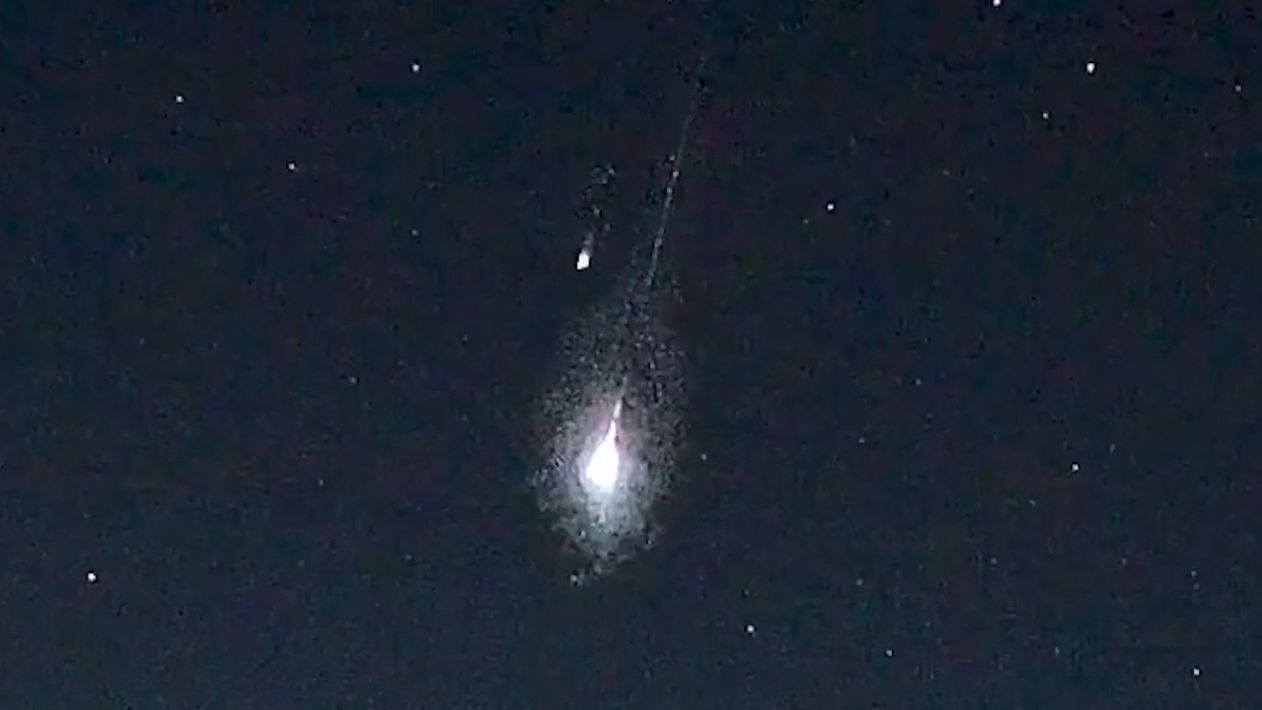Science
Bright Meteors Dazzle Eastern U.S. Skies, Optical Illusion Revealed

On the evening of October 16, 2023, spectators across several states on the Eastern Seaboard of the United States witnessed a stunning display in the night sky. A bright green fireball streaked towards Earth, leaving a luminous trail before it flared and vanished near the horizon. Adding to the spectacle, a video captured from North Branford, Connecticut, appeared to show a second meteor moving in sync with the first, disappearing simultaneously as they neared the ground.
The following night, another fireball was spotted over North Branford from a different location, once again accompanied by a second meteor that mirrored its trajectory. This led many to wonder whether these were truly rare occurrences of ‘double meteors’ or simply an optical illusion.
Expert Analysis on the Phenomenon
According to Robert Lunsford, a fireball expert with the American Meteor Society, these double fireball events may actually result from an optical illusion created by the camera systems used to capture the footage. Lunsford explained that the cameras, which are typically housed under clear acrylic domes, can produce misleading images during bright meteor events.
“These fireballs were captured by the same type of camera systems which are prone to produce ‘double fireballs’ on the brightest events,” Lunsford stated in an email to Space.com. He pointed out that the secondary meteors consistently appear in the same position relative to the primary fireball in both videos. This suggests that the phenomenon is likely a byproduct of the camera’s design rather than an actual astronomical event.
Understanding the Visual Effects
For those intrigued by this celestial display, it is essential to understand that while the visual effects can be captivating, they may not reflect reality. The phenomenon highlights the importance of considering the technology behind astrophotography when interpreting such events.
If you are interested in capturing your own images of meteors, resources are available to guide you through the process. A comprehensive guide to photographing fast-moving meteors, along with recommendations for the best lenses and cameras for astrophotography, can help enthusiasts and budding astronomers alike.
In conclusion, while the allure of double fireballs may spark excitement, it is crucial to approach these visual phenomena with a discerning eye. The beauty of the night sky continues to captivate, even as we uncover the science behind its mysteries. For those who wish to share their own astrophotography, submissions are welcomed by Space.com at [email protected].
-

 Science4 weeks ago
Science4 weeks agoALMA Discovers Companion Orbiting Giant Red Star π 1 Gruis
-

 Top Stories2 months ago
Top Stories2 months agoNew ‘Star Trek: Voyager’ Game Demo Released, Players Test Limits
-

 Politics2 months ago
Politics2 months agoSEVENTEEN’s Mingyu Faces Backlash Over Alcohol Incident at Concert
-

 World2 months ago
World2 months agoGlobal Air Forces Ranked by Annual Defense Budgets in 2025
-

 World2 months ago
World2 months agoMass Production of F-35 Fighter Jet Drives Down Costs
-

 World2 months ago
World2 months agoElectrification Challenges Demand Advanced Multiphysics Modeling
-

 Business2 months ago
Business2 months agoGold Investment Surge: Top Mutual Funds and ETF Alternatives
-

 Science2 months ago
Science2 months agoTime Crystals Revolutionize Quantum Computing Potential
-

 Top Stories2 months ago
Top Stories2 months agoDirecTV to Launch AI-Driven Ads with User Likenesses in 2026
-

 Entertainment2 months ago
Entertainment2 months agoFreeport Art Gallery Transforms Waste into Creative Masterpieces
-

 Business2 months ago
Business2 months agoUS Government Denies Coal Lease Bid, Impacting Industry Revival Efforts
-

 Health2 months ago
Health2 months agoGavin Newsom Critiques Trump’s Health and National Guard Plans









